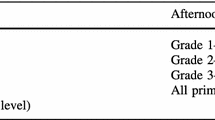Abstract
The paper outlines the first phase of a three-year research activity on active learning in the core curriculum subject, intended as a possible solution to student disengagement in secondary schools. The paper presents the problem the research intend to attack - school failure, school unsuccess, student disengagement and early school leaving - and describes the context of the research, its originality, and the remedial measures put in place by the research team and policy makers. Among those, Continuing Professional Development (CPD) of teachers and structural measures to involve several stakeholders, including students. Then, the research design is given and the research tools presented, showing what dimensions are investigated. Finally, it provides some preliminary results as for one of the four qualitative case studies being carried out and future research perspectives.
This article has been developed jointly by authors. Silvia Panzavolta wrote the Sects. 1, 2, 4.1 and 4.3. Chiara Laici wrote the Sects. 3, 4.2, 4.3 and 5
Access this chapter
Tax calculation will be finalised at checkout
Purchases are for personal use only
Similar content being viewed by others
Notes
- 1.
NEET = Not in Education, Employment or Training.
- 2.
In order for a Pole to be formally created, there must be at least: two Technical or Vocational schools, at least two companies and one institute delivering post-secondary non-tertiary courses (ISCED 4). These institutions must sign a formal agreement where medium-term objectives (for 3 years), a governance organization and committees are identified.
- 3.
From now onwards, in the text we will refer to the 2 moments as pre-CDP and post-CPD.
- 4.
Definitions of SEN students vary widely across countries as they are specific to each country’s legislation. In Italy SEN students are made up of three main group: disabled student, student with learning disorder (i.e. dyslexia), students with socio-cultural disadvantages (Ministry of Education Note NO.8 issued on March 6th 2013).
References
European Commission: Reducing early school leaving: key messages and policy support, Brussels, p. 4 (2013)
European Commission: Taking stock of the Europe 2020 strategy for smart, sustainable and inclusive growth, Brussels (2014)
Law-Decree no. 5, 02 September 2012
Decree of the Tuscan region no. DD 4782/2013
Decree of the Tuscan region no. DGR 420/2014
Frabboni, F.: Il laboratorio. Roma-Bari, Laterza (2004)
Frabboni, F.: Il laboratorio per imparare ad imparare. Tecnodid, Napoli (2005)
Dewey, J.: Esperienza e Educazione. La Nuova Italia, Firenze (1984)
Nigris, E., Negri, S.C., Zuccoli, F.: Esperienza e didattica: le metodologie attive. Carocci, Roma (2007)
McKenzie, W.: Intelligenze multiple e tecnologie per la didattica. Erikson, Trento (2005)
Laici, C., Mosa, E., Orlandini, L., Panzavolta, S.: “Avanguardie educative”: a cultural movement for the educational and organizational transformation of the Italian school. In: Conference Proceedings “The Future of Education”. Libreriauniversitaria.it Edizioni (2015)
La didattica laboratoriale nei Poli Tecnico-Professionali. http://www.indire.it/progetto/didattica-laboratoriale-poli-tecnico-professionali/
Ito, M., Baumer, S., Bittanti, M., Boyd, D., Cody, R., Herr-Stephenson, B., Horst, H.A., Lange, P.G., Mahendran, D., Martínez, K.Z., Pascoe, C.J., Perkel, D., Robinson, L., Sims, C., Tripp, L.: Hanging Out, Messing Around, and Geeking Out: Kids Living and Learning with New Media. The MIT Press, Cambridge (2010)
Fabbri, L., Melacarne, C.: Apprendere a scuola Metodologie attive di sviluppo e dispositivi riflessivi. Franco Angeli, Milano (2015)
Rivoltella, P.C.: Fare didattica con gli EAS. La Scuola, Brescia (2013)
Falcinelli, F.: Le tecnologie dell’educazione. In: Rivoltella, P.C., Rossi, P.G. (eds.) L’agire didattico. Manuale per l’insegnante. La Scuola, Brescia (2012)
Rossi, P.G.: Tecnologie e costruzione di mondi. Post-costruttivismo, linguaggi e ambienti di apprendimento. Armando, Roma (2009)
Jonassen, D.H., Howland, J., Marra, R.M., Crismond, D.: Meaningful Learning with Technology, 3rd edn. Merrill/Prentice Hall. Columbus, OH (2008)
Lamb, S., Markussen, E., Teese, R., Sanberg, N., Polesel, J. (eds.): School Dropout and Completion: International Comparative Studies in Theory and Policy. Springer, Netherlands (2011)
Boscolo, P.: La fatica e il piacere di imparare. UTET, Torino (2012)
De Beni, R., Moè, A., Cornoldi, C., Meneghetti, C., Fabris, M., Zamperlin, C., De Min Tona, G: Test AMOS. Abilità e motivazione allo studio: prove di valutazione e orientamento per la scuola secondaria di secondo grado e l’università. Erickson, Trento (2014)
Varisco, B.M.: Portfolio. Valutare gli apprendimenti e le competenze. Carocci, Roma (2004)
Rossi, P.G., Giannandrea, L.: Che cos’è l’e-portfolio. Carocci, Roma (2006)
Mosa, E., Panzavolta, S., Storai, F.: What feedback for teachers? A pilot for the teacher as a reflective practitioner. IAFOR, ECE (2015)
Creemers, B.P.M., Kyriakides, L.: Using educational effectiveness research to improve the quality of teaching practice. In: Day, C. (ed.) The Routledge International Handbook of Teacher and School Development. Routledge, London (2012)
Hattie, J.A.C.: Visible Learning: A Synthesis of over 800 Meta-analyses Relating to Achievement. Routledge, London-New York (2009)
Kampylis, P., Punie, Y., Devine, J.: Promoting effective digital-age learning - a European framework for digitally-competent educational organisations (2015). doi:10.2791/54070
Acknowledgments
The authors wish to thank Carlo Beni, data analysis responsible, for his precious contribution.
Author information
Authors and Affiliations
Corresponding author
Editor information
Editors and Affiliations
Rights and permissions
Copyright information
© 2017 ICST Institute for Computer Sciences, Social Informatics and Telecommunications Engineering
About this paper
Cite this paper
Panzavolta, S., Laici, C. (2017). Active Learning and ICT in Upper Secondary School: A Possible Answer to Early School Leaving. In: Vincenti, G., Bucciero, A., Helfert, M., Glowatz, M. (eds) E-Learning, E-Education, and Online Training. Lecture Notes of the Institute for Computer Sciences, Social Informatics and Telecommunications Engineering, vol 180. Springer, Cham. https://doi.org/10.1007/978-3-319-49625-2_3
Download citation
DOI: https://doi.org/10.1007/978-3-319-49625-2_3
Published:
Publisher Name: Springer, Cham
Print ISBN: 978-3-319-49624-5
Online ISBN: 978-3-319-49625-2
eBook Packages: Computer ScienceComputer Science (R0)




